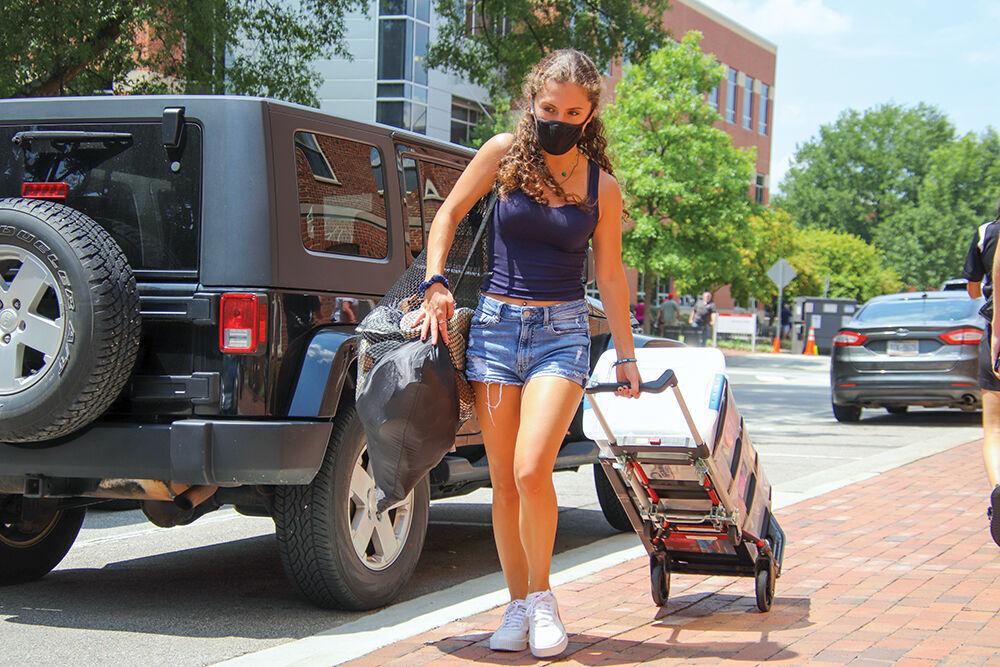With the introduction of NC State’s largest freshman class ever, NC State University Housing has re-implemented full-capacity student housing, C-Stores, in-person programs and more.
Although it’ll take a couple of semesters to see how the 2020-21 school year affected move-in trends, one significant change has already been made: the overall number of RAs and housing staff has lowered.
“We did an analysis, and we looked at the national norms for ratios of staff to residents,” McGalliard said. “And so, we did reduce the number of RAs on campus overall. But that was a result of that strategic initiative, it was not as a result of the pandemic or anything like that.”
Though housing staff is reduced, student occupancy has grown tremendously compared to last year.
“The only thing that changed from the first year class perspective is that this set is huge, just a really big class,” said Donna McGalliard, the executive director of University Housing. “There’s over 5,000 right now. It’s a lot of first year students, and we’re really excited about that.”
The stunningly low occupancy rate in the spring — less than 5,000 students on campus — made it hard to predict any fall semester trends, even in the wake of a return to in-person classes.
“It’s just hard to know what people are feeling at this point in the pandemic,” McGalliard said. “We’re not totally out of it, but I think we’re sailing into a period where we’re starting to recognize that it may just be with us.”
Although first-year students didn’t have the opportunity to preference their building choices, an option the class of 2024 was also denied, they were allowed to choose their roommate under the tentative guarantee that student housing would be operating at full capacity.
“What we had heard from specific students was, ‘I’d rather live with the person that I know than live in a specific location,’” McGalliard said. “But what was happening was they were preferencing buildings, and then their roommate wouldn’t have preferenced the same one all the time.”
Although this has been the process for a few years, some incoming first-years were surprised by the lack of options when it comes to choosing a dorm. Heather Lee, a first-year studying political science, said she lucked out by ending up at Bragaw Hall.
“I was kind of surprised that they weren’t doing it this year,” Lee said. “I’ve been told by upperclassmen, you can choose and you want to choose Bragaw because that’s one of the nicer ones. I was kind of surprised that I ended up lucking out at Bragaw.”
Bragaw Hall, newly reopened after a flooding incident at the beginning of 2021, is home to the Eco Village. Living and Learning Village applications were the only way students could select the dorms they want to live in — so long as the Living and Learning Village pertains to their interests and hobbies. This year, the competition was stiff, especially for Bragaw.
“I applied to Eco [Village] — it was more competitive than I thought,” Lee said. “My short paragraph did not put me through, but I ended up in Bragaw anyways.”
Kenza Nsanzimana, a first-year student studying psychology, lives with Lee in Bragaw and hopes the university won’t repeat fall 2020’s exodus.
“I think the worst-case scenario is if we have to go back home,” Nsanzimana said. “I’d rather just — I don’t mind doing [classes] in dorms.”
In spite of the fact that much of University Housing has reopened to students, some disease mitigation strategies have remained as the delta variant continues to sweep the nation, like surveillance testing, virtual programming and hand-sanitizing stations.
Despite the rush of students to campus, coronavirus-era limitations and suite-style living spaces have made it difficult for some students, including Lee and Nsanzimana, to safely socialize with fellow first-years.
“In terms of socializing and other things, I get along with my other suitemates, they’re all really cool,” Nsanzimana said. “But personally, we went to Owen [Hall] and I thought that was way more social, that they’re all on the same floor.”













